
|   |

|   |
EVAM 2023 - Dr. Rajiv Rajamani e-mail: rajivrajamani1@gmail.com Photos: Suresh Muraleedharan February 16, 2023 Rasa Bodhi Arts Foundation presented a two day festival 'Evam 2023' on January 27 at Veer Sawarkar auditorium and January 29 at St Andrews auditorium in Mumbai. Day 1 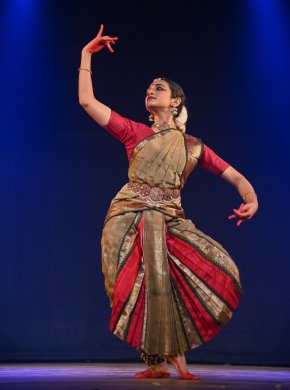 Kavya Ganesh Kavya Ganesh imbued the introduction to Ponniah Pillai's Perum Kovil in Shri Ragam with her own imprint - an evocative Namavali of Shiva. This was followed by a powerful jathi which burst upon the stage with a jolt of energy. The young dancer is struck by wonder as she faces the vimana of the Brihadishvara Temple at Thanjavur, the mere ambit of her gaze giving us a sense of its towering height crowned by the colossal capstone. She imbibes dance movements from sculptures in the temple. She explores rhythm inspired by Nandi who sits unwavering, juxtaposing movement and stillness, nritta at full speed contrasting with statuesque poses! The music breaks into a crescendo of scintillating tanams as the dancer plays the veena - a little artistic license being taken in the ascending or descending slide across the frets. The rousing fervour of temple worship brings about a catharsis in both the Narthaki and Rasika even before the charanam. And yet the finale is actually only the beginning. Kavya breaks into a Namaskara at the very culmination of her dance - like Natyarambha, which marks the start of the young dancer's terpsichorean journey. Kavya is indeed a rare artiste who commits wholeheartedly to the consummate movements choreographed by her Guru Rama Vaidyanathan and performs with a gusto. She pushes every pushable nritta button, even buttons that one hardly realised were there!  Sathyanarayana Raju Sathyanarayana Raju lent an entirely new dimension to the Bharatanatyam experience - quite different in temperament, more emotionally mature. His stage presence is commanding with a quality of dignity infrequently seen. The Tanjore Quartet's Sami Ninne Kori was replete with rich musical textures spanning eight ragas. Sathyanarayana Raju lent the role of the Nayika sufficient depth of experience; her interaction with Thanjapurisha was all it needed to be and more. The choreography may best be described by the term auchitya or appropriateness. It was gripping when it needed to be, light-hearted when it needed to be, always intelligently as well as competently executed. The nayika did not pine away in abject viraha, instead she remained confident of her hold over the Lord. The dancer did not hurtle headlong into jathi interludes. Instead, his nritta was full of gravitas - the strong sweeping movements of long arms, dropping low, levitating the frame in utplavanas of supreme artistry and somehow landing like a feather. Sathyanarayana Raju delineated the firm structure of the Varnam with dynamic builds, exciting punctuation and sometimes a cross rhythm that made one miss a breath. The choreography of Thyagaraja's Ganamurthe and Lalgudi Jayaraman's Shri Durga Jagadishvari in Ahir Bhairav which followed gave expression to the multifaceted abhinaya and narrative prowess of Sathyanarayana Raju. The Bharatanatyam guru's words at the end were a rousing inspiration to new generations of Bharatanatyam dancers, who were present in large numbers. 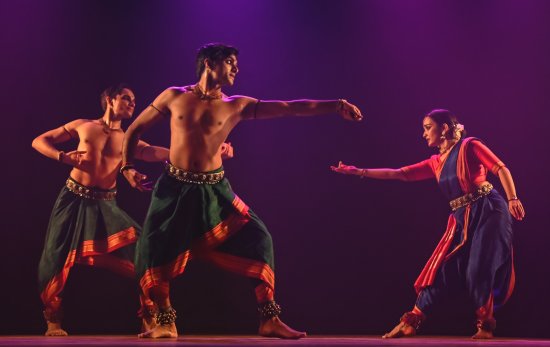 Nagamandala Nagamandala is a production of great dramatic subtlety that reveals Parshwanath Upadhye's adeptness at interpreting not only classical but also folk dance and newer movement vocabularies. It is a stunning interpretation of a folk tale of unrequited love from North Karnataka. The dancers gave a stunning interpretation to build on Rani's frustration when her husband rejects her. They did so by repeating the scene over and over within a narrow lane of light, as if futilely running a race against time. The work is full bodied as all the dancers exuded strong energies. It is full of magic - a flower caught in a beam of golden light, fingers twirling in an ephemeral glow, Adithya PV's sinuous arms and torso metamorphosing into the Naga. Bodies dance singly or come together to give flesh to what relationships look and feel like. Every attitude and movement is emotionally charged - sensual, not sexual. A solo dancer searching for love, perhaps facing his or her own desire to dance with another. Duet cameos of unity and loss. Threesomes that point to more possibilities, provoking an audience that is hungry for understanding. Yet for all its intensity the dancers also grounded the work with humorous relatability, drawing rich applause as Rani's (Shruti Gopal) earthy innocence is transformed into strength. The compelling stage lighting and the stimulating score of folk instruments with vernacular melodies helped sustain the allure of the story. Day 2 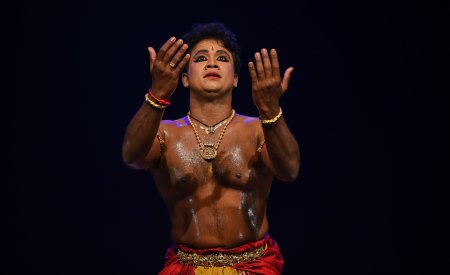 Kali Veerapathiran Kali Veerapathiran's platform performance was particularly galvanizing. It was a real pleasure to see a young dancer simply enjoying himself on stage, copiously drenched in the vim and vigour of the dance. Kali whirled through beautifully, elevating choreographer and composer Nirmala Nagaraj's Kirthanam - Thaandavam Aadum Paadhane in Hamsanandi. But it was not merely the practised precision of the Kalakshetra bani and variations of the thematic vocabulary that informed his dance. An array of emotionally charged expressions and gestures communicated feelings of incredible beauty, awe, longing and wonder. When Kali locked eyes with his beloved Nataraja, he seemed to be bathed with an inner light conjuring to mind words from the Sermon on the Mount - "If thine eye be single, thy whole body shall be full of light." 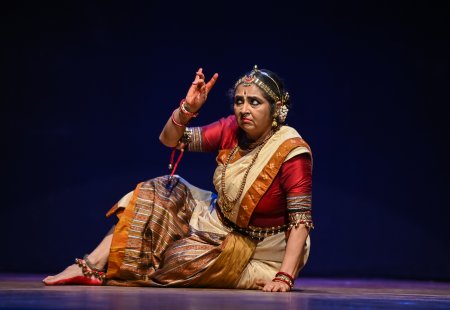 Sharmila Biswas Sharmila Biswas's presentation, Vilasini was a moving exposition of the life of an aging Mahari or Devadasi of Jagannath Puri who reminisces about her old days. The rare composition enlightened the audiences about the aharya (attire and adornments) of the Odissi dancers of yore. The performance was full of lighter moments - comic grace, tempered by melancholic nostalgia, finally subsumed by the sheer joy of dancing. The repertoire and fresh choreography amplified each other. Only such re-stagings can acquaint new generations first hand with the artistic past. A choreography only truly exists when it is embodied in the presence of an audience. Sharmila Biswas has to be applauded for this worthwhile effort. 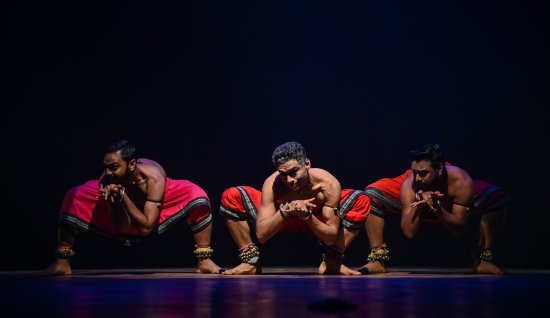 Koushik Das, Samrat Dutta and Subhajit Khush Das The young dancers Koushik Das, Samrat Dutta and Subhajit Khush Das drew thunderous applause for their imaginative interpretation of Jayadeva's Dashavatara Stotram in "Srishti Tatva". Once again the production underscored how traditional repertoire can be interpreted in innovative ways. The evolution of life and ascent of man was depicted with dynamism and a contemporary take. The novel possibilities of new life forms emerging in the post pralaya world was fascinating. 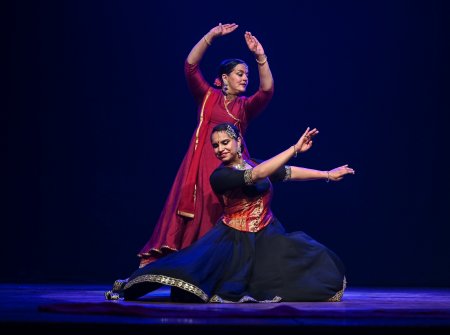 Gauri Sharma Tripathi & Tarini Gauri Sharma Tripathi transported the audience beyond the world of names and forms into an innerscape of light and colours, a link between earthly existence and rapturous divine love. It was a work that overwhelmed the senses in its technical prowess, exuberance, and joy. It was a hypnotic evocation of the power of Kabir's poetry and the songs of Sufi masters through Kathak. The dance and music underscored a work of art that could not exist without equality in the exchange between two rivers of civilization and generations of artistes! The whirling, vibrating energy remained in the body long after the stage lights had dimmed. When the lights came on again the dance fraternity and rasikas were thrilled to see three generations of dancers Guru Padma Sharma, Gauri and Tarini linked by the sacred thread of Guru - Shishya Parampara. Year on year, "Evam" avers what dance can do for the human spirit and soul. The festival nourishes the diverse classical dance forms and makes them relevant by always grounding every item with context. The lack of a contextual framework provided by authentic repertoire often leads to structural oblivion that increasingly pervades contemporary productions these days. Kudos to Keerthana Ravi and her team for pulling off yet another edition of "Evam" that has come to stay in the dance calendar of Mumbai. 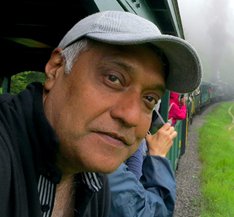 Rajiv Rajamani is a film maker, author and connoisseur of classical music and dance based in Bombay, Auckland and Chennai (during the season). |